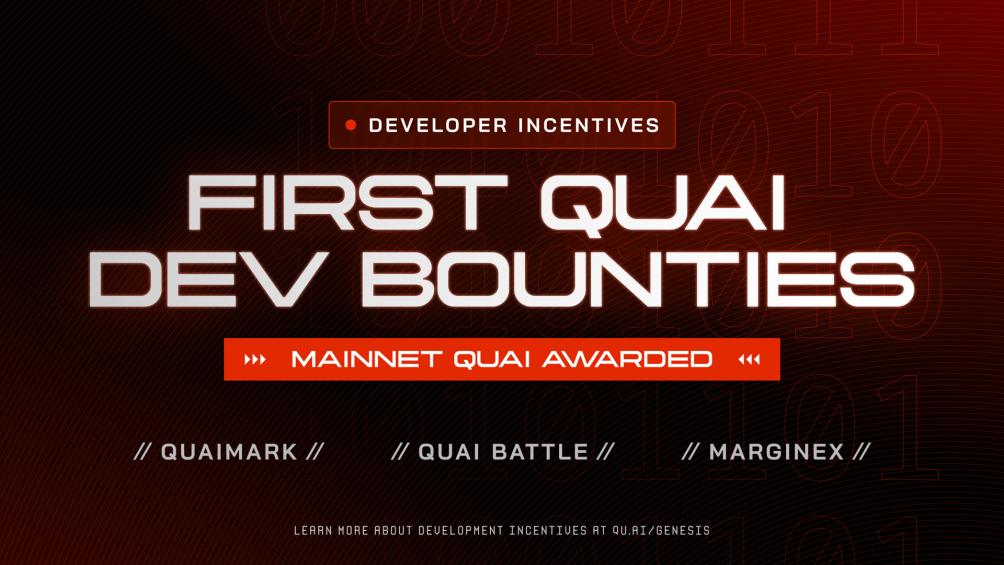
Our team at Dominant Strategies is excited to share the first recipients of a Quai Development Bounty: QuaiMark, QuaiBattle, and MarginEx.
The Quai Network bounty program offers a path for developers to be rewarded for building applications on Quai Network. The bounty program is distinct from the Quai Genesis grants program, which is designed for more formal and long-term partnerships.
Distributed Bounties
Since the launch of the bounty program, a variety of developers have been building, deploying, and improving their projects on Quai Network. Today, we’re excited to share that the following projects have been officially awarded bounties:
- Quai Mark (Twitter) — The first functional NFT Marketplace on Quai, offering functionality for buying/selling NFTs on Cyprus-1.
- Quai Battle (Twitter) — The first functional game on Quai Network, acting as a token-based battle-royale with skins as NFTs on Cyprus-1.
- MarginEx (Twitter) — The first NFT Marketplace on Quai to offer a no-code frontend for users to deploy their own NFTs on Cyprus-2.
Each of these projects has received an award of Mainnet Quai tokens to be distributed upon Quai Network’s Mainnet launch.
These bounties are just the beginning — there are still plenty of bounties available:
- One more bounty available for an NFT Marketplace
- Three bounties available for DEXs
- An unlimited number of bounties available for other, miscellaneous projects
If you’re building a more elaborate project/integration, be sure to check out the Quai Genesis grants program that has a rewards pool of over $10 million!
If you have experience developing on Ethereum or other EVM-compatible blockchains, you likely already have all the skills necessary to build a project worthy of claiming a bounty! Start digging into the development docs here, and feel free to hit up any member of the Dominant Strategies team if you run into issues.
Developer Resources
Quai Network is a new Layer-1 blockchain, meaning the developer ecosystem is still in its early days; however, due to Quai’s use of the EVM, there are many parallels between developing on Ethereum and developing on Quai.
The largest difference between developing on Quai and Ethereum is the SDK used; development on Quai is currently only supported through use of the Quais SDK (a fork of the Ethers SDK).
Some valuable documentation, repositories, tutorials, and communities are linked below for aspiring Quai developers:
- Quai Network single-chain deployment tutorial
- Quai Network multi-chain deployment tutorial
- Quais example repository
- RPC Endpoints
- Network information
- Quai Dev Discord Server (Join here if you need any help!)
DISCLAIMER
Opinions, ideas, and statements shared in this update are delivered with numerous assumptions, risks, and uncertainties which are subject to change over time. There are multiple risk factors, including those related to blockchain, cryptographic systems, and technologies generally, as well Quai’s business, operations and results of operations, that could cause actual results or developments anticipated not to be realized or, even if substantially realized, to fail to achieve any or all of the benefits that could be expected therefrom. We reserve the right to unilaterally, completely, or partially change plans, expectations, and intentions stated herein at any time and for any reason, in our sole and absolute discretion, and we undertake no obligation to update publicly or revise any forward-looking statement, whether as a result of new information, future developments, or otherwise. ACCORDINGLY, WE RECOMMEND THAT YOU DO NOT RELY ON, AND DO NOT MAKE ANY FINANCIAL DECISION OR INVESTMENT BASED ON, THE STATEMENTS CONTAINED IN THIS UPDATE OR ANY OF OUR UPDATES/ARTICLES — INCLUDING BUT NOT LIMITED TO ANY SELLING OR TRADING OF QUAI TOKENS, ETHER, OR ANY OTHER CRYPTOGRAPHIC OR BLOCKCHAIN TOKEN, OR THE SECURITIES OF ANY COMPANY.
The views, opinions, and statements made in this update are those of an individual author and not those of any institution, University, or legal entity operating within the jurisdiction of The United States or beyond. There is no association between these views, opinions, and statements and any for-profit or non-profit entity, particularly with Universities, Foundations, and other Agencies located within the United States. Any perception of such an association is purely accidental, and will be rectified immediately if brought to our attention by the reader.
